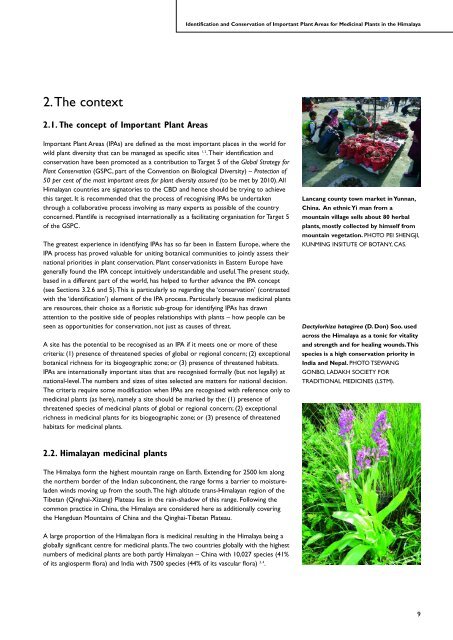Identification and Conservation of Important Plant Areas - Plantlife
Identification and Conservation of Important Plant Areas - Plantlife
Identification and Conservation of Important Plant Areas - Plantlife
- No tags were found...
Create successful ePaper yourself
Turn your PDF publications into a flip-book with our unique Google optimized e-Paper software.
<strong>Identification</strong> <strong>and</strong> <strong>Conservation</strong> <strong>of</strong> <strong>Important</strong> <strong>Plant</strong> <strong>Areas</strong> for Medicinal <strong>Plant</strong>s in the Himalaya2.The context2.1. The concept <strong>of</strong> <strong>Important</strong> <strong>Plant</strong> <strong>Areas</strong><strong>Important</strong> <strong>Plant</strong> <strong>Areas</strong> (IPAs) are defined as the most important places in the world forwild plant diversity that can be managed as specific sites 1, 2 .Their identification <strong>and</strong>conservation have been promoted as a contribution to Target 5 <strong>of</strong> the Global Strategy for<strong>Plant</strong> <strong>Conservation</strong> (GSPC, part <strong>of</strong> the Convention on Biological Diversity) – Protection <strong>of</strong>50 per cent <strong>of</strong> the most important areas for plant diversity assured (to be met by 2010).AllHimalayan countries are signatories to the CBD <strong>and</strong> hence should be trying to achievethis target. It is recommended that the process <strong>of</strong> recognising IPAs be undertakenthrough a collaborative process involving as many experts as possible <strong>of</strong> the countryconcerned. <strong>Plant</strong>life is recognised internationally as a facilitating organisation for Target 5<strong>of</strong> the GSPC.The greatest experience in identifying IPAs has so far been in Eastern Europe, where theIPA process has proved valuable for uniting botanical communities to jointly assess theirnational priorities in plant conservation. <strong>Plant</strong> conservationists in Eastern Europe havegenerally found the IPA concept intuitively underst<strong>and</strong>able <strong>and</strong> useful.The present study,based in a different part <strong>of</strong> the world, has helped to further advance the IPA concept(see Sections 3.2.6 <strong>and</strong> 5).This is particularly so regarding the ‘conservation’ (contrastedwith the ‘identification’) element <strong>of</strong> the IPA process. Particularly because medicinal plantsare resources, their choice as a floristic sub-group for identifying IPAs has drawnattention to the positive side <strong>of</strong> peoples relationships with plants – how people can beseen as opportunities for conservation, not just as causes <strong>of</strong> threat.A site has the potential to be recognised as an IPA if it meets one or more <strong>of</strong> thesecriteria: (1) presence <strong>of</strong> threatened species <strong>of</strong> global or regional concern; (2) exceptionalbotanical richness for its biogeographic zone; or (3) presence <strong>of</strong> threatened habitats.IPAs are internationally important sites that are recognised formally (but not legally) atnational-level.The numbers <strong>and</strong> sizes <strong>of</strong> sites selected are matters for national decision.The criteria require some modification when IPAs are recognised with reference only tomedicinal plants (as here), namely a site should be marked by the: (1) presence <strong>of</strong>threatened species <strong>of</strong> medicinal plants <strong>of</strong> global or regional concern; (2) exceptionalrichness in medicinal plants for its biogeographic zone; or (3) presence <strong>of</strong> threatenedhabitats for medicinal plants.Lancang county town market in Yunnan,China. An ethnic Yi man from amountain village sells about 80 herbalplants, mostly collected by himself frommountain vegetation. PHOTO PEI SHENGJI,KUNMING INSITUTE OF BOTANY, CAS.Dactylorhiza hatagirea (D. Don) Soo. usedacross the Himalaya as a tonic for vitality<strong>and</strong> strength <strong>and</strong> for healing wounds.Thisspecies is a high conservation priority inIndia <strong>and</strong> Nepal. PHOTO TSEWANGGONBO, LADAKH SOCIETY FORTRADITIONAL MEDICINES (LSTM).2.2. Himalayan medicinal plantsThe Himalaya form the highest mountain range on Earth. Extending for 2500 km alongthe northern border <strong>of</strong> the Indian subcontinent, the range forms a barrier to moistureladenwinds moving up from the south.The high altitude trans-Himalayan region <strong>of</strong> theTibetan (Qinghai-Xizang) Plateau lies in the rain-shadow <strong>of</strong> this range. Following thecommon practice in China, the Himalaya are considered here as additionally coveringthe Hengduan Mountains <strong>of</strong> China <strong>and</strong> the Qinghai-Tibetan Plateau.A large proportion <strong>of</strong> the Himalayan flora is medicinal resulting in the Himalaya being aglobally significant centre for medicinal plants.The two countries globally with the highestnumbers <strong>of</strong> medicinal plants are both partly Himalayan – China with 10,027 species (41%<strong>of</strong> its angiosperm flora) <strong>and</strong> India with 7500 species (44% <strong>of</strong> its vascular flora) 3, 4 .9
















